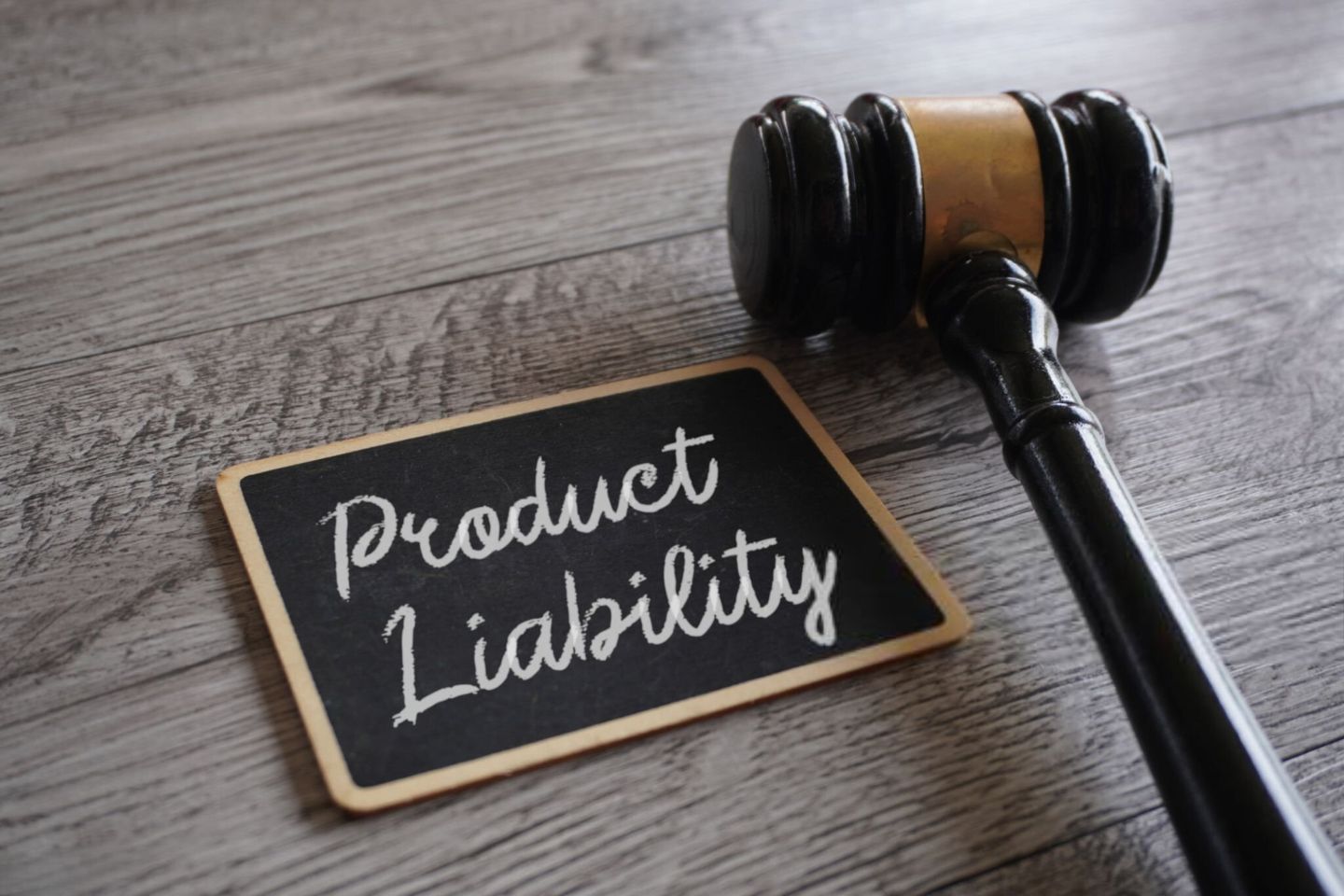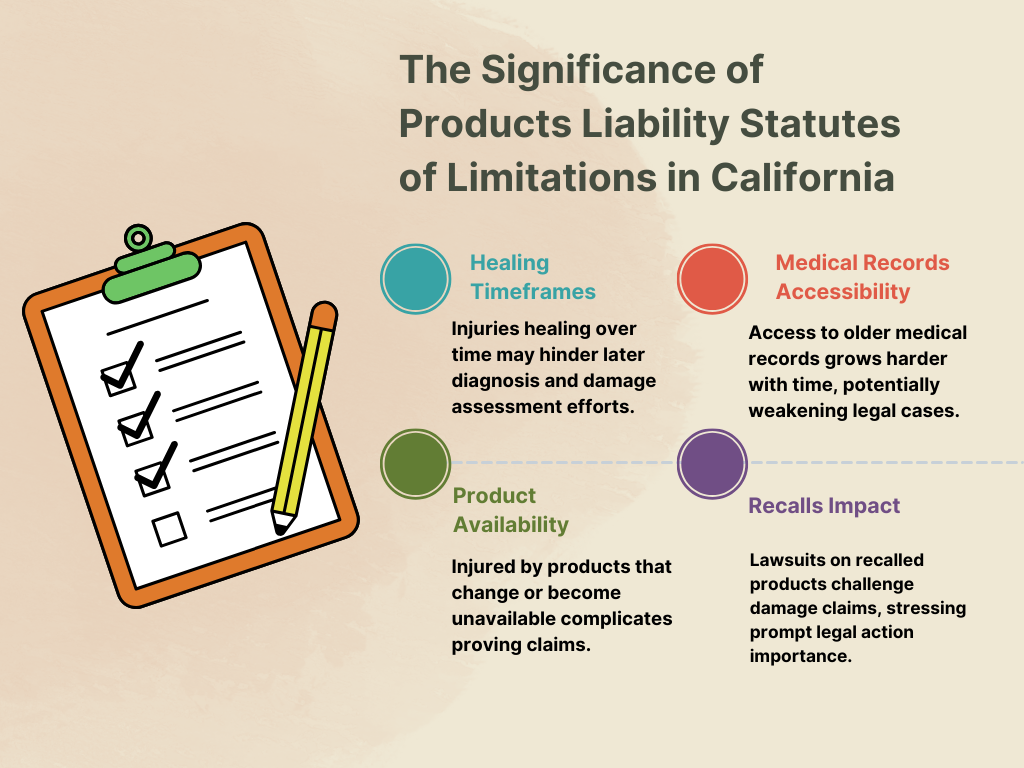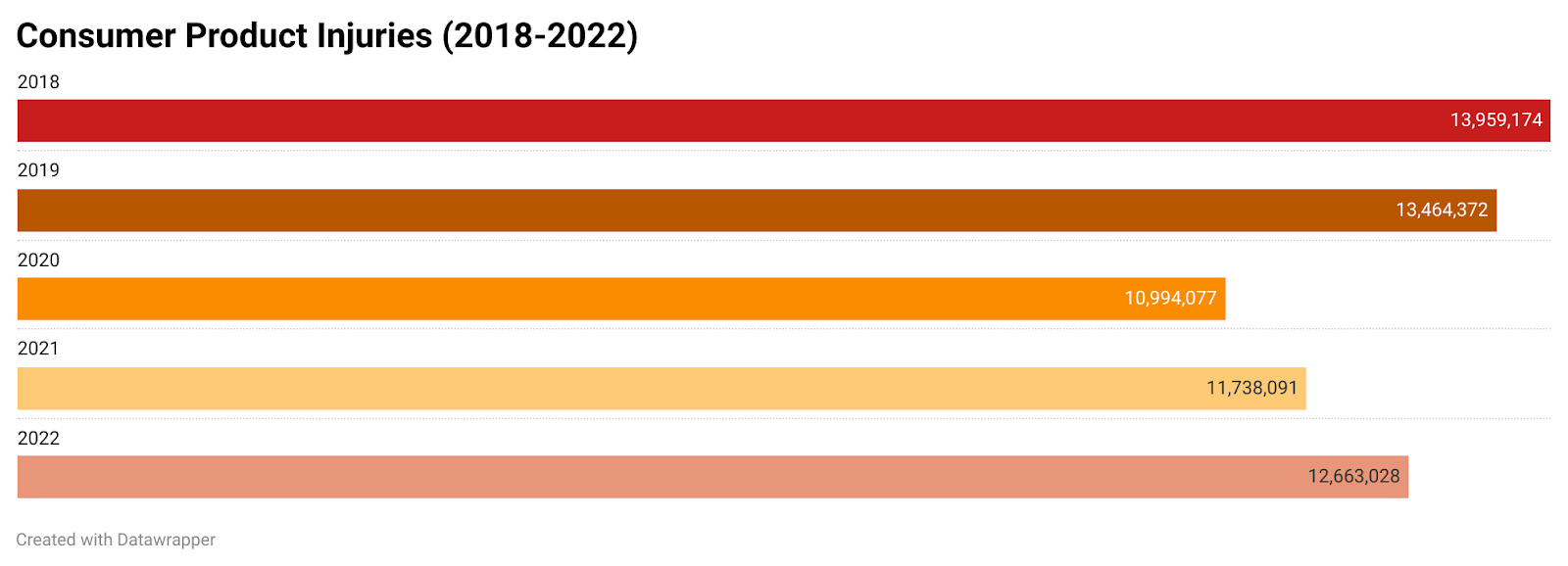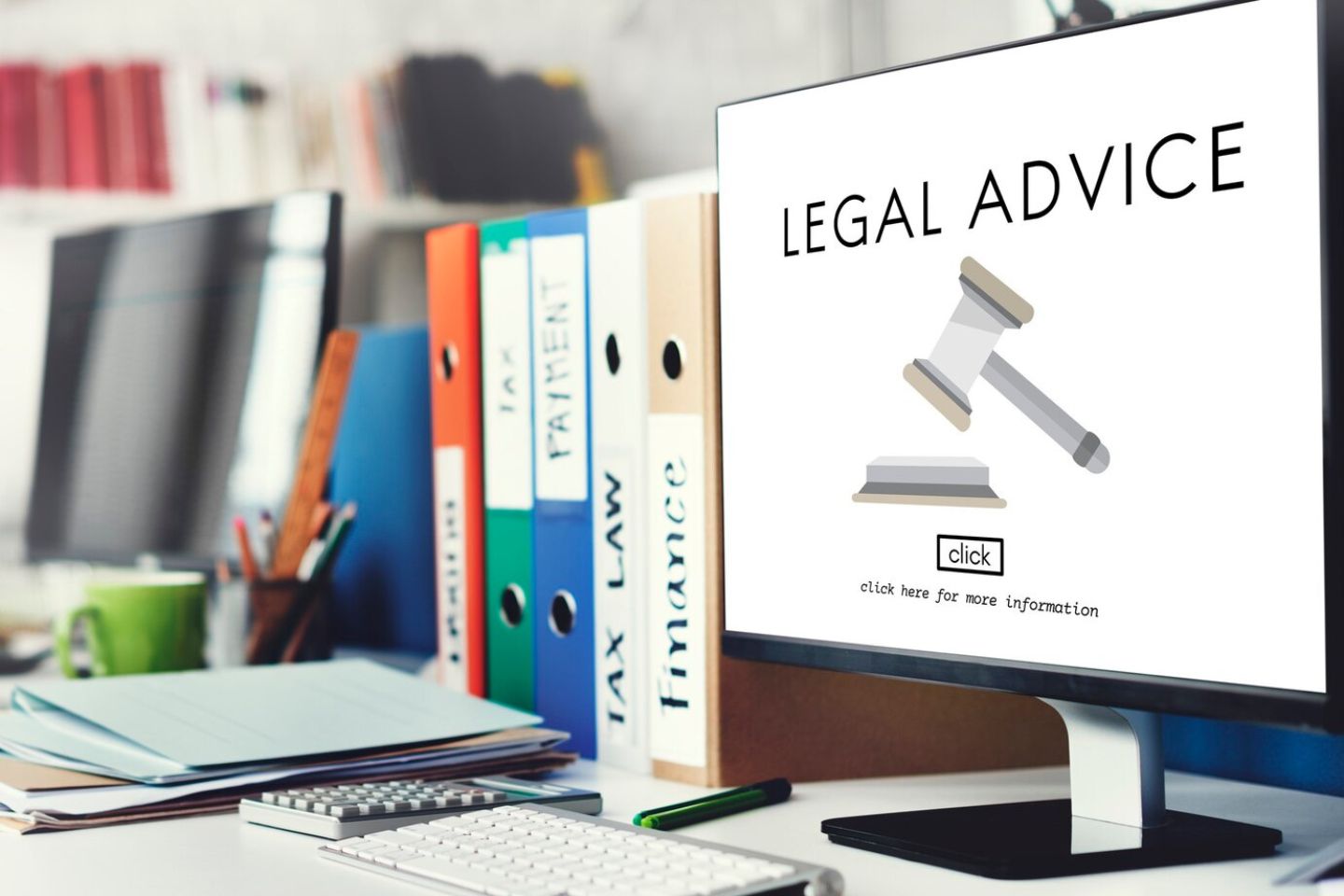Data from 2019 shows that numerous consumer products caused injuries severe enough to require emergency room visits in the United States. In California, if you or someone close to you has been harmed by a product that’s either dangerous or flawed, you have the right to pursue legal action against the company responsible. This process is known as filing a product liability claim.
It’s important to understand that defective products can enter the market in various ways. However, California has strict deadlines, known as statutes of limitations, which dictate how long you have to take your claim to court after an injury. Specifically, these laws give you a limited timeframe to initiate a product liability lawsuit, ensuring that claims are made promptly.
This article will provide a comprehensive overview of the product liability statute of limitations in California. It’ll explore how to effectively navigate the legal system and enhance your chances of securing the compensation you deserve.
- Understanding Product Liability Statute of Limitations in California
- What Leads to the Failure of Products
- The Significance of Product Liability Statutes of Limitations in California
- Product Safety and Legal Responsibilities for Manufacturers in California
- Seeking Compensation in Product Liability Cases in California
- Most Common Cases of Product Liability in California
- Navigating the Product Liability Lawsuit Process in California
Understanding Product Liability Statute of Limitations in California


A defective product may have design flaws, manufacturing errors, or a lack of necessary warnings about its risks. Such products can lead to consumer injuries or property damage. In California, if you’re injured by a defective product, you can hold the responsible company accountable. This is pursued through a product liability claim, a type of lawsuit based on strict liability.
Product Liability Statute of Limitations: Timing is Crucial
According to the law, you are required to file product liability claims within two years of the injury date. This makes it essential to initiate the claim within this period, though the case doesn’t need to be resolved within these two years. Unlike other claims, the statute of limitations for product liability starts when the injured party becomes aware of or should have reasonably discovered their injuries.
Exceptions to Product Liability Statute of Limitations
- Special Considerations for Property Damage: If a defective product causes property damage, you have three years from the damage date to file your lawsuit. However, filing within two years is advisable to also cover any injury claims.
- Minors Have More Time: For individuals under 18, the two-year countdown begins on their 18th birthday, giving them until their 20th birthday to file a lawsuit.
For further clarification and to ensure you get the maximum compensation, reaching out to The Personal Injury Center is a wise step. We’ll pair you with professionals skilled in presenting strong evidence during settlement negotiations, enhancing your chances of a favorable outcome.
What Leads to the Failure of Products
Understanding the flaws in products is crucial. Defects mainly result from design issues, manufacturing errors, or insufficient warnings. This knowledge is key to determining product liability in California:
Defective Design
In California, when a product’s design is in question, courts apply either the risk/benefit test or the consumer expectations test to assess liability:
- The Risk/Benefit Test: This is utilized when evaluating technical aspects of a product’s design, like cost, practicality, and the balance between risk and benefit. A design is considered defective if its inherent risks outweigh its benefits.
- The Consumer Expectations Test: This test is applied when no expert opinion is needed to establish that a product does not perform safely as an ordinary consumer would expect under normal or foreseeable use.
Manufacturing Defect
Even if a manufacturer exercises utmost care throughout the production process, a product may still emerge defective. In such cases, claims are filed under strict liability for manufacturing defects. This means you don’t need to prove negligence on the manufacturer’s part—only that the product was defective and caused injury.
Inadequate Warnings or Instructions
A product might be designed and manufactured to perfection, yet still pose a risk due to insufficient warnings or instructions. For instance, if a drone is prone to losing power and crashing after three hours of flight, but the manufacturer fails to warn consumers of this risk, the product is considered defective. Proper warnings and instructions are crucial for preventing injuries from otherwise safe and well-made products.
The Significance of Product Liability Statutes of Limitations in California


The statutes of limitations for product liability are critical in all injury-related legal cases, including product liability claims in California, for several key reasons:
- Healing Timeframes: Over time, injuries may heal, complicating the process of diagnosing them again or evaluating the associated damages later on.
- Medical Records Accessibility: As years go by, accessing older medical records becomes increasingly difficult, potentially weakening your case.
- Product Availability: The product causing the injury might no longer be available, or it could have undergone changes or deterioration, making it hard to prove your claim.
- Recalls Impact: Many defective products are recalled eventually. Filing a lawsuit for an injury caused by a product that has already been recalled can influence your ability to secure damages. The U.S. Consumer Product Safety Commission keeps an updated list of recalled products, highlighting the significance of acting promptly when initiating a lawsuit.
Product Safety and Legal Responsibilities for Manufacturers in California
Manufacturers play a crucial role in ensuring the products we use daily are safe. Here’s what they are legally required to do:
- Uphold a Duty of Care: Manufacturers must act with a reasonable level of care, similar to what would be expected of any careful manufacturer in the same situation. This duty is foundational to preventing harm to consumers.
- Strive for Safety: The goal isn’t to create flawless products but to significantly minimize the risk of consumer injuries. Achieving perfection isn’t the expectation; ensuring safety is.
- Implement Safe Design Practices: From the drawing board onward, safety must be a priority. This involves careful design planning to avoid potential hazards.
- Consult Experts: Engaging with safety and health experts ensures that manufacturers are aware of and can address potential risks effectively.
- Test Products Thoroughly: Rigorous testing helps identify and eliminate possible safety issues before products reach the consumer market.
- Regular Inspections: Constantly checking the production line and products helps catch and correct errors early in the manufacturing process.
- Train Employees Properly: Well-trained workers are less likely to make mistakes that could lead to unsafe products being made.
- Respond to Consumer Complaints Swiftly: Taking quick action on feedback can prevent further injuries and demonstrates a commitment to consumer safety.
- Acknowledge Liability for Dangerous Products: Even without proving negligence, manufacturers can be held strictly liable for any injuries caused by defective products. This legal principle, known as strict product liability, aims to protect consumers by simplifying the process of seeking compensation.
Seeking Compensation in Product Liability Cases in California
If you’ve been injured by a defective product, you’re entitled to pursue compensation. This compensation aims to cover the broad impact of the injury, from physical and emotional suffering to financial losses.
Here’s a simplified breakdown of what you can claim:
- Medical Expenses: You can claim costs for all medical needs arising from your injury. This covers hospital stays, surgeries, medication, rehabilitation, and any future medical treatments needed due to the defective product.
- Lost Wages and Future Earnings: If the injury forced you to miss work, compensation could cover your lost wages. If your ability to work and earn in the future is compromised, you can seek compensation for future income losses.
- Pain and Suffering: Beyond physical injuries, a defective product can inflict emotional distress and reduce your quality of life. Compensation can be sought for these non-tangible impacts, considering the severity and longevity of your suffering.
- Property Damage: If the defective product also damaged your property, like a car or personal items, you can claim the costs needed for repairs or replacements.
If you’re dealing with an injury from a defective product, don’t hesitate to reach out to the Personal Injury Center. We’ll connect you with seasoned personal injury attorneys dedicated to maximizing your compensation, ensuring you receive the support and justice you deserve.
Most Common Cases of Product Liability in California


There are several possibilities of product liability claims, covering any product that might cause harm due to defects. Beyond the common categories, different cases illustrate the complex nature of product liability law.
Whether it’s a defective car component or a hazardous household item, understanding these categories can help identify potential claims and the variety of products that might be involved. Some common categories of product liability cases are:
- Consumer Products: Every home is filled with items that could potentially lead to a product liability claim, from hazardous cleaning products to faulty furniture. This category includes a wide array of household items.
- Automotive Equipment: A significant portion of product liability involves automotive parts failing to perform safely. Examples include airbags that don’t deploy in a crash or brake components that fail under normal use. Sometimes, the design of the vehicle itself might be at fault, such as a tendency to roll over during regular operation.
- Children’s and Babies’ Toys: The youngest are particularly at risk. Toys that pose choking hazards, contain toxic chemicals, or could lead to electrocution are examples of defects that could harm children. Manufacturers failing to warn about such risks might be held liable.
- Medical Devices: Designed to improve health or save lives, medical devices, and pharmaceuticals can, unfortunately, cause significant harm if they fail. Such failures can result in serious injuries or disabilities.
- Building Materials: Even the materials used in constructing homes can give rise to liability claims. From asbestos in older buildings to lead paint, or even defects in permanent fixtures like swimming pools, the potential for harm is present.
Navigating the Product Liability Lawsuit Process in California


When facing a product liability case, starting off with the right understanding is crucial. Here’s a step-by-step guide to navigating the process effectively:
- Document Everything: First, gather all evidence related to the defective product. Take clear photos of the product and any injuries it caused. If you can, keep the product’s original packaging, box, and instruction manual. The more documentation you have to support your injury claim, the better.
- Seek Medical Attention: Your health comes first. Visit a doctor immediately to treat your injuries. This not only prioritizes your recovery but also provides medical records that serve as important evidence for your case.
- Consult a Lawyer: After addressing your medical needs, consult with an experienced lawyer. A lawyer understands the details of products liability statute of limitations in California and can review your case to outline your legal options. They play a crucial role in managing your process, from conducting investigations and filing your claim to negotiating settlements or representing you in court.
If you’re dealing with injuries from a defective product in California, it’s important to reach out to The Personal Injury Center. We’ll connect you with seasoned lawyers who ensure you meet all legal requirements and gather the necessary evidence to build a strong case against the responsible company.
Key Takeaways
|



